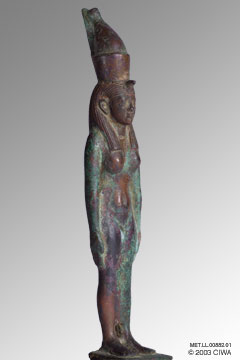
| Period: | | Egypt, Graeco-Roman Period, Ptolemaic Period |
| Dating: | | 304 BC–200 BC |
| Origin: | | Egypt, Upper Egypt, Thebes |
| Material: | | Bronze |
| Physical: | | 17.8cm. (7 in.) - 387 g. (13.7 oz.) |
| Catalog: | | MET.LL.00882 |
Links to other views:
⇒ Larger View
if scripting is off, click the ⇒ instead.
• • •
Links to others from Ptolemaic Period
Bronze ithyphallic god Bes, Ptolemaic
Bronze of Eros, Ptolemaic, 200-100 BC
Bronze statuette of Aphrodite, Ptolemaic
Bronze Venus, Alexandria, 50 BC-50 AD
Gold and cornaline necklace, Alexandria
Gold ring, Ptolemaic Period, 304-30 BC
Grooved bowl, Syro-Palestine, 150-50 BC
Horus-the-Child, Alexandria, 100-30 BC
Horus-the-Child, Alexandria, 304-30 BC
Horus-the-Child, Ptolemaic, 200-100 BC
Horus-the-Child, Ptolemaic, 304-30 BC
Horus-the-Child riding a swan, 304-31 BC
Tall bronze Osiris, Ptolemaic Period
Links to others representing Mut
Queen as Goddess Mut, Dyn.18
Queen Hatshepsut as Goddess Mut, Dyn. 18
Links to others of type Statuette-woman
Bronze female dancer, Rome, 200-27 BC
Bronze goddess Neith, Ptolemaic Period
Bronze of a queen nursing, Dyn. 25
Bronze of Ceres, Rome, 200 BC-307 AD
Bronze of Goddess Nebethetepet, Dyn. 12
Bronze Venus, Alexandria, 50 BC-50 AD
Etruscan young woman, 570-550 BC
Gilded statue of a queen, Early Dynastic
Hathor as a woman, cow headed, N.K.
Protodynastic female statuette, Dyn. 0
Queen Aqaluqa as Isis nursing, Dyn. 25
Queen as Goddess Mut, Dyn.18
Queen as Isis nursing, Dyn. 12
Queen as Isis nursing, Dyn. 25
Queen as Isis-Hathor nursing, Dyn. 21
Queen Hatshepsut as Goddess Mut, Dyn. 18
Queen Hatshepsut as Hathor, Dyn. 18
Queen Isis as Isis nursing Thutmose III
Queen Isitnefret as Isis nursing, Dyn. 19
Queen Karama as Goddess Neith, Dyn. 22
Terracotta young woman, Greece, 450 BC
Victory and Athena, terracotta, Greece
Woman and girl, Tanagra, 340-300 BC
Woman with elaborate headdress, Crete
|
|
This bronze statuette depicts goddess Mut, wearing the double crown of Upper and Lower Egypt, protected by the Cobra. The red-brown and green patina is particularly attractive, but the proportions and structure of the body: arms, legs and face, even the dress do not comply with the Egyptian physical type--a reflection of the new multiculturalism of the Ptolemaic Period, 304-200 BC.
Bibliography (for this item)
Khalil, Hassan M.
1976 Preliminary Studies on the Sanusret Collection. Manuscript, Musée l’Egypte et le Monde Antique, Monaco-Ville, Monaco. ((1) 291)
|